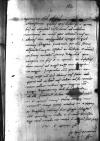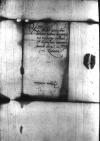Quibus opus habuit Paternitas Vestra Reverendissima litteris ad obtinendam translationem ad Ermland (Warmia, Varmia), diocese and ecclesiastical principality in northeastern Poland, 1466-1772 within the Kingdom of Poland, Royal Prussia⌊ecclesiam VarmiensemErmland (Warmia, Varmia), diocese and ecclesiastical principality in northeastern Poland, 1466-1772 within the Kingdom of Poland, Royal Prussia⌋, et misi per nuntium eius, et alteras hic consignandas Georg Hegel (†1547), the Thurzons' and later the Fuggers' factor in Cracow (worked for the Fuggers at least from 1521); supplier to the royal court in Cracow (PSB 9, p. 336)⌊Georgio HegielGeorg Hegel (†1547), the Thurzons' and later the Fuggers' factor in Cracow (worked for the Fuggers at least from 1521); supplier to the royal court in Cracow (PSB 9, p. 336)⌋ curavi.
Negotia Prutenica per omnia ferme absolventur iuxta cf. other letter Council of Royal Prussia Sigismund I Jagiellon Graudenz (Grudziądz) [1537-10-04], CIDTC IDT 162;
other letter Council of Royal Prussia Jan CHOJEŃSKI Graudenz (Grudziądz) 1537-10-04, CIDTC IDT 163;
other letter Council of Royal Prussia Sigismund I Jagiellon Graudenz (Grudziądz) 1537-10-07, CIDTC IDT 665;
other letter [Council of Royal Prussia] Sigismund I Jagiellon Graudenz (Grudziądz) 1537-10-09, CIDTC IDT 666⌊consilium et conclusacf. other letter Council of Royal Prussia Sigismund I Jagiellon Graudenz (Grudziądz) [1537-10-04], CIDTC IDT 162;
other letter Council of Royal Prussia Jan CHOJEŃSKI Graudenz (Grudziądz) 1537-10-04, CIDTC IDT 163;
other letter Council of Royal Prussia Sigismund I Jagiellon Graudenz (Grudziądz) 1537-10-07, CIDTC IDT 665;
other letter [Council of Royal Prussia] Sigismund I Jagiellon Graudenz (Grudziądz) 1537-10-09, CIDTC IDT 666⌋ Council of Royal Prussia the most important local authority in Royal Prussia. It consisted of two bishops (of Ermland (Warmia), who served as the Council’s president, and of Kulm (Chełmno)), three voivodes (of Kulm, Marienburg (Malbork), and Pomerania), three castellans (of Kulm, Elbing (Elbląg), and Gdańsk (Danzig)), three chamberlains (of Kulm, Marienburg, and Pomerania), and representatives of the three Great Prussian Cities – Gdańsk, Thorn (Toruń), and Elbing (ACHREMCZYK 2016, p. 17-18)⌊Dominationum VestrarumCouncil of Royal Prussia the most important local authority in Royal Prussia. It consisted of two bishops (of Ermland (Warmia), who served as the Council’s president, and of Kulm (Chełmno)), three voivodes (of Kulm, Marienburg (Malbork), and Pomerania), three castellans (of Kulm, Elbing (Elbląg), and Gdańsk (Danzig)), three chamberlains (of Kulm, Marienburg, and Pomerania), and representatives of the three Great Prussian Cities – Gdańsk, Thorn (Toruń), and Elbing (ACHREMCZYK 2016, p. 17-18)⌋ et brevi mittentur istuc. Neque habeo, quo occupem in praesens Dominationem Vestram Reverendissimam, et discessus Cracow (Kraków, Cracovia), city in southern Poland, Małopolska, on the Vistula river, from 1038 capital of the Kingdom of Poland⌊hincCracow (Kraków, Cracovia), city in southern Poland, Małopolska, on the Vistula river, from 1038 capital of the Kingdom of Poland⌋ meus ad Ferdinand I of Habsburg (*1503 – †1564), from 1521 Archduke of Austria, from 1526 King of Bohemia and Hungary, Croatia and Slavonia as Ferdinand I, 1531-1558 King of the Romans, 1558-1564 Holy Roman Emperor; son of Philip I the Handsome and Joanna the Mad of Castile, a younger brother of Charles V of Habsburg⌊regem RomanorumFerdinand I of Habsburg (*1503 – †1564), from 1521 Archduke of Austria, from 1526 King of Bohemia and Hungary, Croatia and Slavonia as Ferdinand I, 1531-1558 King of the Romans, 1558-1564 Holy Roman Emperor; son of Philip I the Handsome and Joanna the Mad of Castile, a younger brother of Charles V of Habsburg⌋ me urget et angit. Impendio enim premor et Ferdinand I of Habsburg (*1503 – †1564), from 1521 Archduke of Austria, from 1526 King of Bohemia and Hungary, Croatia and Slavonia as Ferdinand I, 1531-1558 King of the Romans, 1558-1564 Holy Roman Emperor; son of Philip I the Handsome and Joanna the Mad of Castile, a younger brother of Charles V of Habsburg⌊rex RomanorumFerdinand I of Habsburg (*1503 – †1564), from 1521 Archduke of Austria, from 1526 King of Bohemia and Hungary, Croatia and Slavonia as Ferdinand I, 1531-1558 King of the Romans, 1558-1564 Holy Roman Emperor; son of Philip I the Handsome and Joanna the Mad of Castile, a younger brother of Charles V of Habsburg⌋ nondum certiores nos fecit ad, quemnam in locum nos volet ad se venire, nam adhuc Vienna (Wien, Vienna), city in eastern Austria, on the Danube river⌊ViennaeVienna (Wien, Vienna), city in eastern Austria, on the Danube river⌋ agit, Anna Jagiellon (*1503 – †1547), Queen of Bohemia (1526-1547), Queen of Hungary (1527-1547), Queen of the Romans (1531-1547); wife of Ferdinand I of Habsburg, daughter of Vladislaus II Jagiellon and Anne de Foix⌊reginaAnna Jagiellon (*1503 – †1547), Queen of Bohemia (1526-1547), Queen of Hungary (1527-1547), Queen of the Romans (1531-1547); wife of Ferdinand I of Habsburg, daughter of Vladislaus II Jagiellon and Anne de Foix⌋ vero Prague (Praha, Praga), city in central Bohemia, on the Vltava river, from the 9th century capital of Bohemia, archepiscopal see⌊PragaePrague (Praha, Praga), city in central Bohemia, on the Vltava river, from the 9th century capital of Bohemia, archepiscopal see⌋. Exspectamus hac hebdomada ab Ferdinand I of Habsburg (*1503 – †1564), from 1521 Archduke of Austria, from 1526 King of Bohemia and Hungary, Croatia and Slavonia as Ferdinand I, 1531-1558 King of the Romans, 1558-1564 Holy Roman Emperor; son of Philip I the Handsome and Joanna the Mad of Castile, a younger brother of Charles V of Habsburg⌊illoFerdinand I of Habsburg (*1503 – †1564), from 1521 Archduke of Austria, from 1526 King of Bohemia and Hungary, Croatia and Slavonia as Ferdinand I, 1531-1558 King of the Romans, 1558-1564 Holy Roman Emperor; son of Philip I the Handsome and Joanna the Mad of Castile, a younger brother of Charles V of Habsburg⌋ significationem de loco.
Cupio bene valere Vestram Dominationem Reverendissimam. Cuius fraterno amori me commendo.


 AAWO, AB, D. 68, f. 163v
AAWO, AB, D. 68, f. 163v